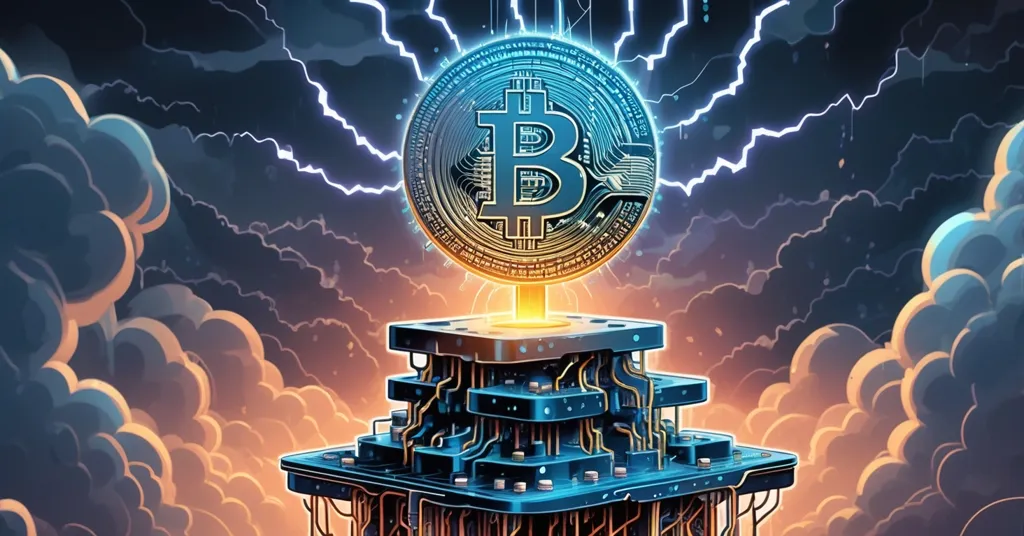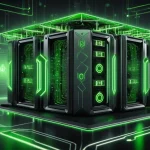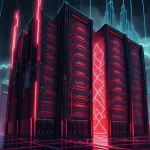Nvidia’s AI Bubble Warning: Lessons for Bitcoin and Crypto Speculation

Nvidia’s AI Surge: A Cautionary Tale for Bitcoin and Crypto Enthusiasts
Jay Goldberg, a Wall Street analyst, has planted himself as the lone skeptic in a sea of Nvidia cheerleaders, slapping a rare sell rating on a company whose stock has exploded over 3,000% since 2020. With Nvidia’s valuation hitting a dizzying $4.5 trillion on the back of AI fervor, Goldberg’s warning of a bubble—reminiscent of the dot-com crash—strikes a nerve for those of us in the Bitcoin and crypto space, where speculative manias are old news. Is this AI gold rush a mirror to our own excesses, and what can we learn before the next bust?
- Lone Dissenter: Jay Goldberg stands as the only analyst among 80 covering Nvidia with a sell rating, against overwhelming bullish sentiment.
- AI Overdrive: Nvidia’s growth is powered by massive AI spending, but questions loom over sustainability and real-world returns.
- Crypto Parallels: The AI bubble debate echoes crypto’s history of hype, with shared risks in overvaluation and energy demands impacting Bitcoin and beyond.
Nvidia’s Meteoric Rise: A Tech Titan on Shaky Ground?
Nvidia has emerged as the unchallenged heavyweight of the tech sector, its graphics processing units (GPUs) fueling the AI revolution from chatbots to autonomous systems. Since the dawn of 2020, its stock has become the S&P 500’s top performer, ballooning to a market cap of roughly $4.5 trillion. The engine behind this ascent? Unprecedented investments from six juggernauts—Microsoft, Alphabet (Google’s parent), Amazon, Meta, Oracle, and OpenAI. The five publicly traded among them are on track to shell out nearly $400 billion in capital expenditures this year, a staggering 67% leap from last year, while OpenAI alone eyes a trillion-dollar spend on AI initiatives. It’s a frenzy that rivals the wildest Bitcoin bull runs or the 2017 ICO boom in our own backyard.
GPUs, for the uninitiated, are specialized chips that handle complex computations at lightning speed, making them indispensable for AI model training and, in earlier days, Bitcoin mining before ASICs (application-specific integrated circuits) took over. Nvidia’s dominance in this hardware space has turned it into a linchpin for tech giants racing to build the next big thing. But while the numbers dazzle, cracks are starting to show—or so says Jay Goldberg, the Deutsche Bank analyst who’s betting against the tide.
Out of 80 analysts tracking Nvidia, Goldberg is the sole bear, setting a price target far below the Wall Street consensus. While others predict rosy highs, with recent shares closing around $186, Goldberg sees doom on the horizon. His reasoning isn’t just contrarian noise; it’s a calculated jab at the blind faith propelling AI hype, as detailed in a recent analysis of his unique stance on Nvidia’s overvaluation.
“There’s a lot more that can go wrong with Nvidia than can go right,”
Goldberg cautions. He points to a house of cards built on unproven returns, drawing a haunting comparison to the dot-com bubble of the early 2000s, when internet companies soared on promises of a digital utopia only to implode as profits never materialized. Cisco Systems, once a darling of that era, cratered after infrastructure spending outpaced actual demand—a ghost story Goldberg sees repeating.
“That feels very strongly like the pattern we’re seeing now. We’re going to build up all this AI stuff for largely psychological reasons. At some point, the spending will stop, and the whole thing will tumble down, and we’ll reset,”
he predicts. It’s not hard to see why this hits home for crypto folks. We’ve lived through our own dot-com moments—think the 2017 ICO craze, where startups raised millions on whitepapers alone, or the 2022 Terra-Luna debacle, where an algorithmic stablecoin’s collapse wiped out $40 billion overnight due to unsustainable mechanics.
Hidden Risks: Energy, Leverage, and Fragile Chains
Goldberg doesn’t stop at historical parallels. He digs into practical vulnerabilities that could unravel Nvidia’s empire, from electricity shortages for sprawling data centers to over-leveraged property deals propping up AI infrastructure. For clarity, data centers are massive facilities packed with servers and GPUs running 24/7, guzzling power like a small city. The “neoclouds” he mentions are niche cloud services tailored for AI workloads, often entangled in complex real estate and energy contracts that scream risk if one link snaps.
“Once you trace down where all these GPUs are going, you get into the weeds of the neoclouds and all these electricity and property deals that are taking place. It’s easy to see how some obscure company fails and that cascades down the rest of the supply chain,”
Goldberg warns. Picture a domino effect: a small data center operator defaults on a loan, delays GPU orders, and suddenly a major AI project stalls. It’s not far-fetched, and it mirrors disasters we’ve seen in crypto, like leveraged DeFi protocols collapsing when overextended positions got liquidated en masse.
Even industry insiders are starting to sweat. Goldman Sachs CEO David Solomon has nodded to dot-com déjà vu, while OpenAI’s Sam Altman, whose firm is betting a trillion on AI, didn’t mince words when asked if a bubble exists:
“Yes.”
If the guy leading the charge admits the emperor might be naked, shouldn’t we all take a hard look? Goldberg, ever the curmudgeon, isn’t shocked by the hype—he’s seen this rodeo before.
“I’m probably a little cantankerous by nature, so I’m skeptical of all of the hype around AI right now. This is not my first bubble,”
he quips. He’s the grumpy uncle at the AI hype fest, warning the punch is spiked with delusion. And honestly, his skepticism resonates with anyone who’s watched crypto’s endless cycle of moon promises and rug pulls.
Energy Echoes: AI’s Power Hunger vs. Bitcoin Mining
One glaring overlap between AI and our world of decentralization is energy. The data centers powering AI consume astronomical amounts of electricity to keep thousands of GPUs humming non-stop. Sound familiar? Bitcoin mining, especially under its proof-of-work consensus, relies on specialized hardware solving complex puzzles around the clock, drawing enough power to rival small nations. Both industries face the same grim reality: unchecked growth could strain global grids and invite regulatory hammers.
We’ve already seen this play out with Bitcoin. China’s 2021 mining ban, driven by energy concerns, forced operations to relocate, with places like Texas now hosting miners using renewable energy to dodge criticism. Yet the stigma persists—Bitcoin’s carbon footprint is a lightning rod for detractors. AI’s trajectory isn’t much different. If OpenAI’s trillion-dollar vision materializes, we’re talking power demands that could make mining look like child’s play. Goldberg’s caution about electricity supply isn’t just a footnote; it’s a flashing neon sign for any tech pushing hardware limits.
Could decentralized tech offer solutions? Bitcoin’s layer-2 scaling, like the Lightning Network, aims to cut energy use by offloading transactions from the main chain. Green mining initiatives are gaining traction too. But let’s not kid ourselves—both AI and crypto need brutal honesty about sustainability. If we’re championing effective accelerationism, the push to disrupt via tech, we can’t ignore the real-world walls we’ll hit without smarter resource use.
Speculative Shadows: Crypto’s Own Bubble History
Goldberg’s stance isn’t anti-innovation—he’s got buy ratings on other AI-linked firms like Apple and Broadcom. His beef is with blind faith in a single narrative, a trap crypto enthusiasts know all too well. Our space is littered with cautionary tales. The 2017 ICO bubble saw projects raise billions on vague promises of “blockchain for X,” only to vanish by 2018’s winter. Fast forward to 2021, and DeFi’s total value locked peaked at $180 billion, much of it tied to unsustainable yields that cratered when the hype faded. Don’t even get me started on meme coins—Dogecoin’s pumps are fun until retail investors get burned.
Even Bitcoin, our bedrock of decentralization, isn’t immune to speculative fever. Maximalists like myself see it as the ultimate store of value, a middle finger to centralized finance. But let’s be real—price spikes often ride on FOMO, not fundamentals. Are we so different from AI investors dumping billions into unproven models? Goldberg’s lonely hill is a reminder to question our own cultish devotion to the next big thing, whether it’s BTC at $100K or an altcoin promising to “fix everything.”
What Now for Crypto?
As Nvidia basks in AI glory, Goldberg’s dissent forces us to confront uncomfortable truths. We’re all for disrupting the status quo, for freedom and privacy through decentralized systems. Bitcoin remains king, Ethereum carves its smart contract niche, and altcoins fill gaps with innovation (or scams, let’s be honest). But if AI’s house of cards tumbles, as even Sam Altman hints it might, our own foundations better not be built on sand.
The path forward demands balance. We push for adoption with eyes wide open, learning from AI’s overbuild risks. That means championing real utility—Bitcoin as sound money, Ethereum for programmable finance, not just price pumps. It means tackling energy hogs head-on, whether through renewables or scaling tech. And it means calling out bullshit hype, be it a trillion-dollar AI pipe dream or a shitcoin with a cute mascot. Freedom’s worthless if it fries the grid or fleeces the masses.
Key Takeaways and Questions for Reflection
- Is Nvidia’s AI growth a bubble, and what does it signal for crypto?
Goldberg warns Nvidia’s growth, driven by unproven AI spending, could collapse like past tech bubbles. Crypto must heed this, prioritizing substance over speculative mania in Bitcoin and altcoins. - How do AI energy demands compare to Bitcoin mining challenges?
Both AI data centers and Bitcoin mining devour electricity, risking grid strain and regulation. Sustainable innovation, like green mining or layer-2 scaling, is critical for long-term viability. - What lessons can crypto draw from AI’s speculative risks?
Crypto’s history of ICOs and DeFi crashes mirrors AI hype. We must focus on real-world value—Bitcoin as a store of value, Ethereum for contracts—over empty promises. - Are we in crypto blind to our own bubble tendencies?
Possibly. Even Bitcoin’s price surges can be FOMO-driven. Questioning narratives, as Goldberg does with Nvidia, keeps us grounded against overvaluation risks. - Can decentralized tech avoid AI’s potential pitfalls?
Yes, by embracing effective accelerationism with caution—pushing disruption via Bitcoin and blockchain while addressing energy and hype issues to build a resilient future.
Nvidia’s saga is a stark warning taped to our crypto doorstep. We’re fighting for a decentralized world, cheering Bitcoin’s defiance and blockchain’s promise. But if we ignore the echoes of AI’s unchecked enthusiasm—be it energy crises or bubble bursts—we’re just swapping one flawed system for another. Let’s accelerate, sure, but with a steady hand on the wheel and a sharp eye for the cliffs ahead.



